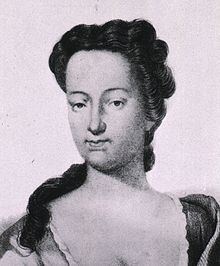Nationality Scottish Name Elizabeth Blackwell | Known for illustrator Role Artist | |
 | ||
Died 1758, London, United Kingdom | ||
Elizabeth Blackwell (1707 – 1758) was a Scottish botanical illustrator and author who was best known as both the artist and engraver for the plates of "A Curious Herbal", published between 1737 and 1739. The book illustrated many odd-looking and unknown plants from the New World, and was designed as a reference work on medicinal plants for the use of physicians and apothecaries.
Contents
Aberdeen
Elizabeth Blachrie,was the daughter of a successful Scottish merchant in Aberdeen and was trained as an artist. She secretly married her cousin, Alexander Blackwell (1709–47), a Scottish doctor and economist and settled in Aberdeen where he maintained a medical practice. Although his education was sound, his qualifications were questioned, leading to the young couple’s hasty move to London, fearing charges that Alexander was practicing illegally.
London
In London, Alexander became associated with a publishing firm, and having gained some experience, established his own printing house, despite not belonging to a guild nor having served the required apprenticeship as a printer. He was charged with flouting the strict trade rules, and heavily fined, forcing him to close his shop.
Prison
By now Blackwell was destitute. Because of Alexander’s lavish spending and the fines that had been imposed, the couple were heavily in debt - Alexander found himself in debtor’s prison. With her husband in gaol, a household to run, a child to care for, and with no income, the situation was desperate. She learned that a herbal was needed to depict and describe exotic plants from the New World. She decided that she could illustrate it, and that Alexander, given his medical background, could write the descriptions of the plants. As she completed the drawings, Blackwell would take them to her husband’s cell where he supplied the correct names in Latin, Greek, Italian, Spanish, Dutch, and German.
Unlike her husband, Blackwell was untrained in botany. To compensate for this, she was aided by Isaac Rand, then curator of the Chelsea Physick Garden, where many of these new plants were under cultivation. At Rand’s suggestion, she relocated near the Garden so she could draw the plants from life. In addition to the drawings, Blackwell engraved the copper printing plates for the 500 images and text, and hand-coloured the printed illustrations.
The first printing of A Curious Herbal met with moderate success, both because of the meticulous quality of the illustrations and the great need for an updated herbal. Physicians and apothecaries acclaimed the work, and it received a commendation from the Royal College of Physicians. A second edition was printed 20 years later in a revised and enlarged format in Nuremberg by Dr. Christoph Jacob Trew, a botanist and physician, between 1757 and 1773.
Revenue from the book led to Alexander’s release from prison. However, within a short while debts again accumulated, forcing the couple to sell some of the publication rights to the book. Alexander also became involved in several unsuccessful business ventures, and eventually left the family to start a new life in Sweden.
Sweden
Blackwell arrived in Sweden in 1742 and carried on with agricultural experiments he had started when in Aberdeen. These included the breeding of horses and sheep, and dairy management. His achievements were recognised, and he was appointed court physician to Frederick I of Sweden. Blackwell attempted to strengthen the diplomatic ties between Great Britain, Denmark and Sweden. As Great Britain had no ambassador in Sweden, he contacted a Minister in Denmark. On circumstantial evidence he was accused of conspiracy against the Crown Prince. He was tried and sentenced to be decapitated. He remained in good spirits to the last - at the block, having laid his head wrong, he remarked that since it was his first beheading, he lacked experience and needed instruction. On 9 August 1747 he was executed as Blackwell was leaving London to join him.
Little is known of Blackwell's later years. She was buried on 27 October 1758, and her grave is at All Saints Church in Chelsea, London. She remained loyal to Alexander throughout, even sharing royalties with him from the sale of additional book rights.
Featured at the British Library
Blackwell's "A Curious Herbal" has featured on the British Library website as a "classic of botanical illustration." The book is available to view online using the Turning the Pages system.
Publications
By : Blackwell, Elizabeth, - Eisenberger, Nicolaus Friedrich, - Trew, Christoph Jacob, - Christiani de Launoy. - Io. Iosephi Fleischmanni. Publication : Norimbergae : Typis Io. Iosephi Fleischmanni, 1750-1773. online and download
